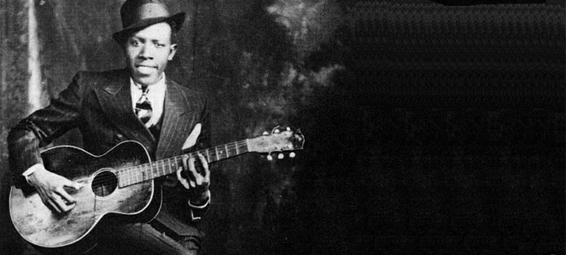When I told a friend that Dallas, TX is a linchpin in the history of rock and roll, she ridiculed the idea. Without even mentioning Blind Lemon Jefferson, T-Bone Walker, and the scores of foundational bluesmen who utilized Dallas as a hub of transport, commerce and performance, I felt like I could effectively make my argument with 508 Park Ave. and the infamous Robert Johnson session that took place there: twenty-five cuts of eighteen songs, 61 minutes and 12 seconds that exerted an authoritative torque on the thousands of hours of popular music that would follow.
Led Zeppelin, the Rolling Stones, and the White Stripes all culled directly from that session, which included “Stop Breakin’ Down Blues,” “Traveling Riverside Blues,” and “Love in Vain.” If it never happened, maybe the same artists would pull as much inspiration from theSan Antonio session Johnson cut seven months before. But it did happen, in Dallas, and without it the landscape of music as we know it would be drastically altered.
Here is the problem, how many people in the U.S.A.– or even Dallas itself — describe the city as “a linchpin for popular music”? Where is the I-35 billboard that makes the claim to drivers entering Dallas? More than a historical landmark, 508 Park Ave. represents Dallas’s misplaced identity, as dormant and abused as the silent brick façade.
The Reverend Dr. Bruce Buchanan has been staring at that brick façade since 1991, when he began working directly across the street at The Stewpot, a social ministry of The First Presbyterian Church. He has seen a lot of people make what he calls “pilgrimages” just to “put their hands on that black marble and say, ‘This is where it began.’” Last year, news outlets reported that the church bought 508 Park Ave, which had been empty for 20 years. At that time, the church revealed plans to renovate the building and adjacent lot both in the interests of historic preservation and social ministry. The inaugural artistic event this coming Tuesday, June 19, shows the church making good on those plans.
The property needed to be purchased by an organization like First Presbyterian, a community that is compelled to do things that seem impossible, impractical, and definitely unprofitable. The building sat for so long because the previous owner could never determine how to turn a buck on a place that sat in commerce-starved downtown Dallas, with a steady line of the homeless and needy on the opposing sidewalk. For First Presbyterian, their purchase of the historically sacred property and ambitious plans to renovate it fit directly into the narratives they understand: resurrection, a stick snatched from the fire.
First Presbyterian has a reputation for advocating on behalf ofDallas’s homeless citizens. In 2007, the city’s crackdown on homelessness drove many of them off public sidewalks and into First Presbyterian’s parking lot. The church could have enlisted the police to kick them out, but believed such a move would be hypocritical, so they let them stay until they found another sanctuary.
Buchanan sees the principles of The Stewpot and restoring 508 Park as one in the same. “You don’t throw things away,” he says. “You don’t throw people away and you don’t throw historical [buildings] away.” As one who frequently works among the city’s “most vulnerable,” Buchanan believes the message of Johnson’s palpable blues has a lot in common with his ministry. “[Robert Johnson] would have a lot of simpatico with the artists at The Stewpot,” he says.
What makes First Presbyterian’s restoration of 508 Park so impressive is their intent to maintain fidelity to the original building. The church just recently located the building’s original specifications in New Orleans and plan on incorporating as much of them as possible into the renovation. First Presbyterian clearly intends to make more of the storied facility than simply an auxiliary space for their social ministry. Restoring not only the original building’s aesthetic beauty, but also its purpose, is a move to restore its dignity.
This last April, First Presbyterian soldiered ahead with their plans, demolishing the building at 1900 Canton, which sat adjacent to 508 Park. An outdoor performance venue and garden will be constructed in its place. Buchanan hopes it will be a place for local musicians can perform in the heart of downtown Dallas next to a musical landmark. Buchanan says plants have already been installed in the space, providing some greenery for the site’s first event this Tuesday. First Presbyterian hopes to have the outdoor space completed by spring 2013.
The first event in the revival of 508 Park Ave. takes place this Tuesday, June 19, which marks the 75th anniversary of Johnson’s historic recording session. Events include a Robert Johnson look-alike/sound-alike contest, a theatrical recreation of that era called On That Day, and performances by several artists including The Light Crust Doughboys, who also recorded in the studio 75 years ago. Predictably, none of the original members remain, but the Doughboys are, by lineage and style, the same group.
June 19, often concatenated as “Juneteenth,” is celebrated as the day when slaves were freed in Texas by official declaration in Galveston in 1865. For 147 years, it has marked a day of hope and the dawn of new paradigms. Robert Johnson’s recording session, by coincidence, fell on the same day 72 years later. For 508 Park Ave, you could hardly compose a better narrative as a building so essential to Dallas’s own story starts its next act.





